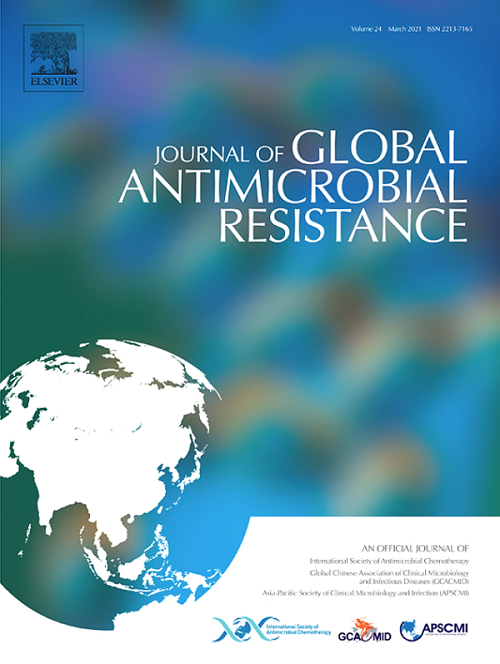伤口感染中的铜绿假单胞菌:基因组特征和高毒力ST1965/ST3418菌株的出现,共同携带exoU和exo。
IF 3.2
3区 医学
Q2 INFECTIOUS DISEASES
引用次数: 0
摘要
目的:研究伤口感染中铜绿假单胞菌的表型和基因型特征。方法:对某大学医院伤口感染分离的76株铜绿假单胞菌进行分析。对所有菌株进行抗菌药敏试验、生物膜形成试验和全基因组测序(WGS)。潜在的高毒力菌株的毒力被评估使用一个大麦孔杆菌感染模型。结果:76株检测菌株中,49株(64.5%)对所有抗菌药物均敏感。β-内酰胺酶编码基因阳性率为57.9%,OprD基因突变率为1.3%。所有分离株被划分为56种不同的多位点序列类型(MLST)。血清型分布显示O11(22.37%, 17/76)、O16(19.74%, 15/76)和O1(18.42%, 14/76)最为常见。exoU基因主要与血清型O11相关。80%以上的菌株携带生物膜相关毒力基因,均表现出较强的生物膜形成能力。鉴定出6株exoU+/exoS+菌株(血清型O4),其中ST1965和ST3418在感染模型中显示出潜在的高毒力。结论:伤口感染中分离的铜绿假单胞菌具有散发的基因组图谱,高抗生素敏感性和强大的生物膜形成。exoU+/exoS+高毒性克隆(ST1965和ST3418)的出现,以增强的毒力和生物膜生成为特征,突出了它们引起治疗难治性感染和严重临床结果的潜力。持续监测和量身定制的治疗方法对于控制这些克隆引起的感染至关重要。本文章由计算机程序翻译,如有差异,请以英文原文为准。
Pseudomonas aeruginosa in wound infections: Genomic characterization and emergence of hypervirulent ST1965/ST3418 strains co-harbouring exoU and exoS
Objective
To investigate the phenotype and genotype characteristics of Pseudomonas aeruginosa isolates from wound infections.
Methods
Seventy-six P. aeruginosa strains isolated from wound infections in a university hospital were analysed. Antimicrobial susceptibility testing, biofilm formation assays, and whole-genome sequencing were performed on all strains. The virulence of potential hypervirulent strains was assessed using a Galleria mellonella infection model.
Results
Among the 76 tested strains, 49 (64.5%) were susceptible to all tested antibiotics. The β-lactamase-encoding gene positivity rate was 57.9%, while the OprD gene mutation rate was 1.3%. All isolates were classified into 56 distinct multilocus sequence types. Serotype distribution revealed O11 (22.37%, 17/76), O16 (19.74%, 15/76), and O1 (18.42%, 14/76) as the most prevalent. The exoU gene was predominantly associated with serotype O11. Over 80% of strains harboured biofilm-related virulence genes, and all exhibited strong biofilm-forming capacity. Six exoU+/exoS+ strains (serotype O4) were identified, with ST1965 and ST3418 demonstrating potential hypervirulence in the infection model.
Conclusions
P. aeruginosa isolates from wound infections displayed sporadic genomic profiles, high antibiotic susceptibility, and robust biofilm formation. The emergence of exoU+/exoS+ hypervirulent clones (ST1965 and ST3418), characterized by enhanced virulence and biofilm production, highlights their potential to cause treatment-refractory infections and severe clinical outcomes. Continuous surveillance and tailored therapeutic approaches are imperative for managing infections caused by these clones.
求助全文
通过发布文献求助,成功后即可免费获取论文全文。
去求助
来源期刊

Journal of global antimicrobial resistance
INFECTIOUS DISEASES-PHARMACOLOGY & PHARMACY
CiteScore
8.70
自引率
2.20%
发文量
285
审稿时长
34 weeks
期刊介绍:
The Journal of Global Antimicrobial Resistance (JGAR) is a quarterly online journal run by an international Editorial Board that focuses on the global spread of antibiotic-resistant microbes.
JGAR is a dedicated journal for all professionals working in research, health care, the environment and animal infection control, aiming to track the resistance threat worldwide and provides a single voice devoted to antimicrobial resistance (AMR).
Featuring peer-reviewed and up to date research articles, reviews, short notes and hot topics JGAR covers the key topics related to antibacterial, antiviral, antifungal and antiparasitic resistance.
 求助内容:
求助内容: 应助结果提醒方式:
应助结果提醒方式:


